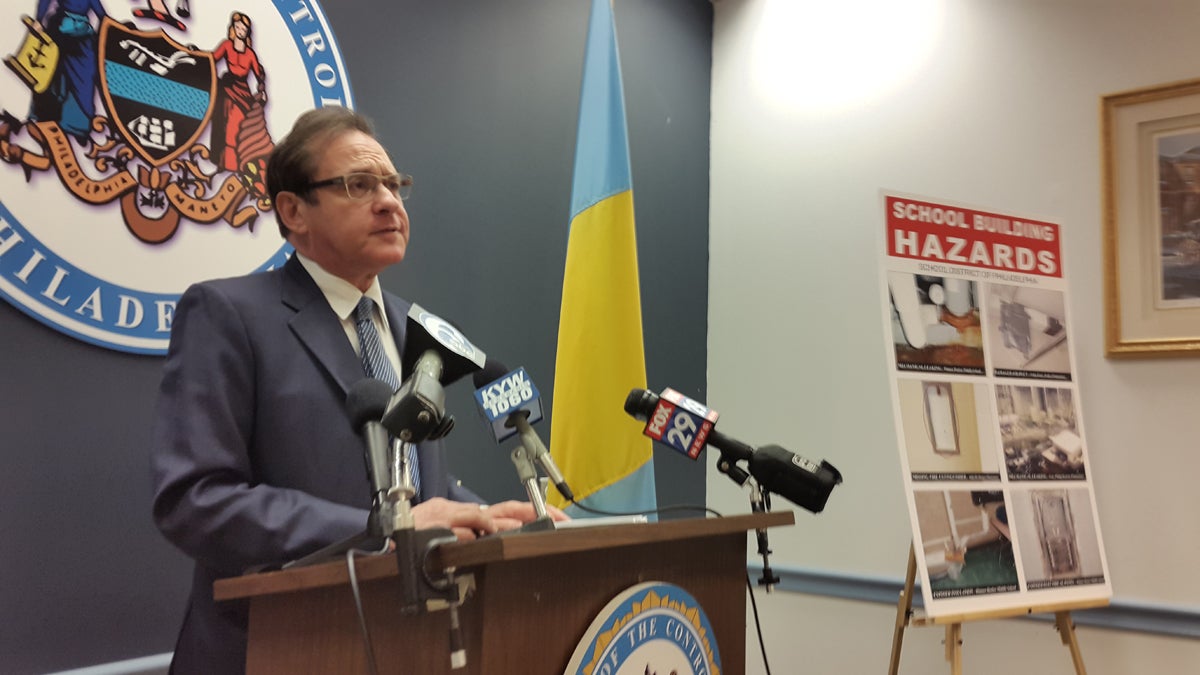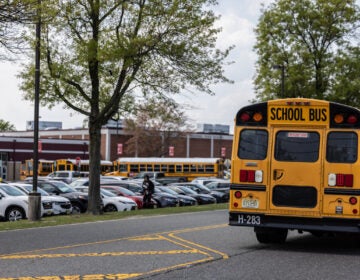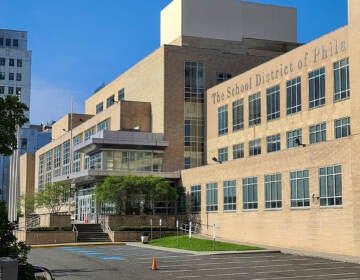Unsanitary, unsafe conditions found in Philadelphia schools
Listen
City Controller Alan Butkovitz shares findings from a report on school conditions with the press. (Laura Benshoff/WHYY)
Periodically, city officials shine a spotlight on the condition of school buildings in the School District of Philadelphia. Not for the first time, what they saw isn’t pretty.
Inspectors from city Controller Alan Butkovitz’s office visited 20 schools between October and March. Their findings, detailed in a report out Wednesday, included electrical hazards, water damage, and permanently clogged toilets in the sample of schools.
According to the report, some problems showed up in a lot of the schools:
70 percent had electrical hazards, such as exposed wiring;
95 percent had water damage, which includes mold;
75 percent had fire hazards, such as missing or out-of-date fire extinguishers.
In some cases, Butkovitz’s staff tried to intervene on the spot for issues they deemed too hazardous, he said. They encountered exposed wiring carrying a 600-volt charge in an unlocked closet at Dimner Beeber Middle School.
And they found unsealed asbestos in a hallway at Francis Scott Key Elementary School. Butkovitz said he received no response to an urgent message he sent to the district regarding the asbestos.
“You’ve got kids in Philadelphia neighborhoods, and they can’t even go to the bathroom because of what they’re going to see … they’ve got to be worried that, if they touch something on the wall, it’s going to electrocute them,” said Butkovitz, who compared bathroom conditions to those in India and other developing countries.
In 2008, the controller’s office issued a similar report, looking at 19 schools. This time, it looked at 10 of those same schools as well as 10 others deemed to be representative of the types and locations of school buildings around the city.
According to the report, many of the schools previously inspected had fixed some earlier problems, but others persisted and new problems were added to the lists.
Engineer Marc Orgovan, who conducted some of the inspections, said most of the serious issues were not located in individual classrooms but in hallways or shared spaces, so it was hard to gauge how many students come into contact with them.
District not surprised by building issues
“Our maintenance budget has declined. There’s no surprises here,” said district spokesman Fernando Gallard.
However, he said, the inspection adds useful information. “It is a snapshot that the School District of Philadelphia needs more funds to maintain its buildings,” said Gallard.
He said he invited the controller to help lobby the state for more money for maintenance, which the district spent $23.9 million on last year. The district is hoping to receive $159 million in the state budget this year, so that it can begin to rehire staff — including custodians — lost in successive waves of firings since 2010.
After the district became aware of the asbestos problem at Key Elementary in May, it capped the exposed insulation, Gallard said.
Kindergarten teacher Dan DiMartino works for Juniata Park Elementary, one of the 20 schools inspected. Since the 2008 report, the school has moved to a new building but problems persist due to an insufficient cleaning staff, he said.
“When the cleaner is out, your room doesn’t get cleaned,” he said, setting the stage for pests.
“I go to move a crate, and I find all my books chewed up. And mouse feces all over the books,” said DiMartino. “I had to trash them.”
He said exterminators sent by the district have been ineffective. However, other safety hazards have been fixed promptly, according to DiMartino, such as a backed-up sewage system that began flowing out of the water fountains.
“When it was something like that, they came out, they tested the air quality … they had to redo everything. But it was addressed,” he said. “But, sometimes, do things need to get that severe to be addressed?”
In the report, Juniata Park was cited for not having adequate fire equipment and signage. DiMartino said he’s never noticed any problems at the school related to fire saftey.
According to Butkovitz, ignoring easy fixes — such as covering exposed wires — will make the problems worse over time. “The longer these low-cost items go unattended, the more severe and costly they will become,” he said.
The district plans to release its own facilities condition assessment later this year, addressing the building conditions of all its properties.
WHYY is your source for fact-based, in-depth journalism and information. As a nonprofit organization, we rely on financial support from readers like you. Please give today.




